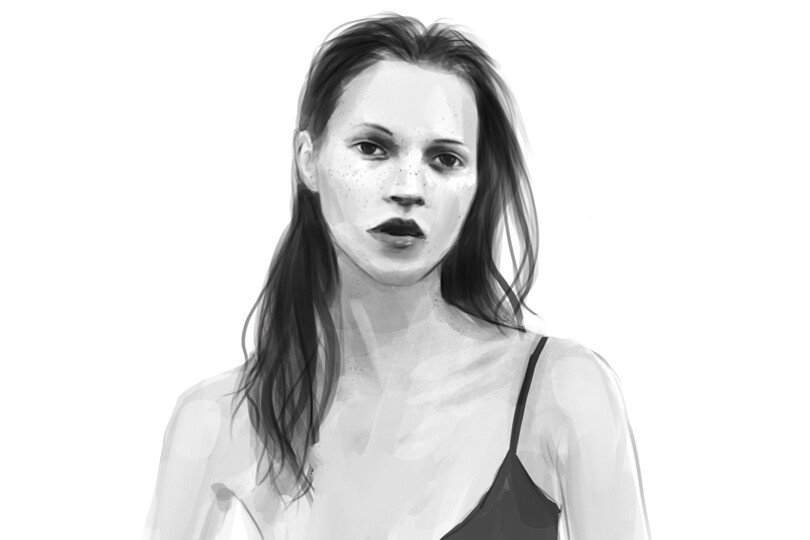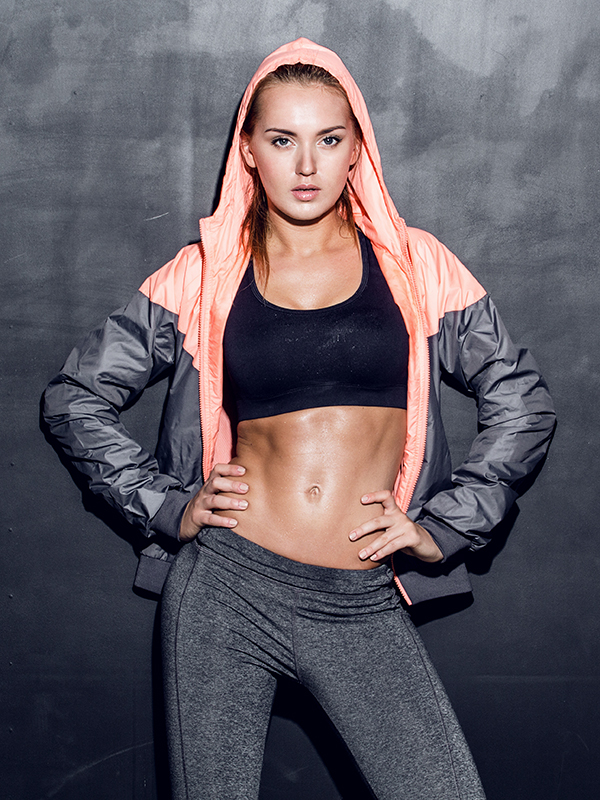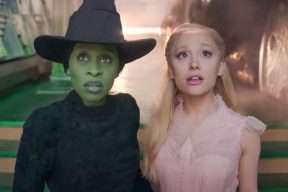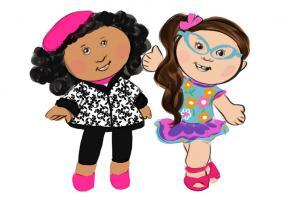Part of an ongoing series of 29Secrets stories, taking a deep dive into the history of legendary beauty products and iconic fashion and pop culture moments…
By Christopher Turner
Illustration by Michael Hak
Kate Moss is undoubtedly one of the greatest supermodels in fashion history. Arriving at the end of the so-called “supermodel era,” Moss rose to fame in the early 1990s, leading the controversial “heroin chic” fashion trend and redefining the entire fashion industry with her waifish figure and natural beauty. Her initial collaboration with Calvin Klein turned her into an instant worldwide sensation and she dominated every major fashion week around the globe throughout her lengthy career, despite being one of the shortest models to ever walk the runway, standing at a “mere” 5’7″.
But how did the London native become a trailblazer and a cultural icon? That’s thanks to two women: Sarah Doukas, owner of the modelling agency Storm, and famed British photographer Corinne Day.
Here’s the story of how Moss became known as the “anti-supermodel” and launched a new era in modelling…though not without a little controversy, of course.
Sarah Doukas and airport finds
Kate Moss was born on January 16, 1974, in Croydon (a large town in south London, England) to travel agent Peter Edward Moss and Linda Rosina, a barmaid. She received her preliminary education from Ridgeway Primary School and later was enrolled at Riddlesdown Collegiate. In 1987, when Moss was 13, her parents divorced, devastating Moss and her younger brother, Nick.
The next year, Moss was “discovered” at JFK Airport in New York City after a holiday in the Bahamas. Moss, then 14, and her father had been waiting three days for standby seats back to England, where they were expected at a wedding, when she was famously approached by Sarah Doukas, the founder of Storm Model Management, and her brother.
“I was smoking,” Moss recalled to Love magazine in 2018. “I was 14 and I’d just lost my virginity. So I thought I was the bee’s knees. I was in the airport puffing away. I’d got on the plane and then Sarah’s brother came up to me and said, ‘Have you ever thought about being a model?’”
Doukas recalls their encounter slightly differently, remembering that she and her brother spotted Moss at the check-in counter where Moss’s father was arguing with people, and then approached father and daughter on the flight back to London.
“As soon as the seat belt sign switched off, we rushed over,” Doukas recalled in Model: The Ugly Business of Beautiful Women by Michael Gross.
Moss’s father had seen Doukas on television and knew she was legitimate. So the next day, back in London, Moss’s skeptical mother agreed to accompany her daughter to meet with Doukas at the Storm offices.
Moss admitted that she had “never, never, never” contemplated a career as a model. “I was short, I had bow legs and crooked teeth, and nobody thought I was the prettiest girl in the school,” she said.
Despite Moss’s insecurities, Doukas, a former model herself, saw potential and recruited Moss to join Storm’s roster of models. She called all of the magazine contacts in her Rolodex and faxed photographs of Moss to everyone she knew.
“Nobody was interested,” she said.
With that inauspicious start, Moss’s career started slowly, with a few unremarkable photo shoots for a variety of different teen magazines.
“She was in school, and I don’t ever agree with taking anybody out of school,” Doukas said in 2015. “We worked on the holidays and stuttered along for a year. But she wasn’t greatly interested in school, and then she left, and then we started. Every day I said, ‘I’m going to make you a star.’ I didn’t know I was going to make her a superstar.”
Doukas had started Storm just the year before with a handful of models she had scouted on her own, and her discovery of Moss – then considered “unconventional” in the age of glamazon supermodels – put the agency on the map. It’s worthy to note that Moss wasn’t to be Doukas’s only discovery: she would go on to launch the careers of Cara Delevingne, Sophie Dahl and Jourdan Dunn, all of whom not only changed the fashion industry for the better, but also became multi-hyphenate talents in their own rights.
The Face
Moss’s career really took off two years later in 1990, when Doukas booked her to pose for a few black and white photographs for the popular youth style magazine, The Face. Renowned British photographer Corinne Day was behind the lens for the shoot, titled “The 3rd Summer of Love.” Day was one of the key players of the early ’90s “grunge” period that was taking over fashion magazines at the time and, like Doukas, she spotted Moss’s potential. She snapped the adolescent in a variety of outfits that had been pulled by stylist Melanie Ward.
“We went out to the beach at Camber Sands…. It was all very instinctual. It felt totally organic: friends hanging out, dressing up and taking photos. There was no grand plan to start a whole new Cool Britannia moment – we were just having fun,” recalled Ward to The Face in 2019. “I always wanted the clothes to look effortless, real, character-driven – like the subject was wearing their own clothes and we were documenting them. I collected up a mix of clothes I liked – some mine, some vintage, customized, even some designer – and put them on Kate. I also remember using Birkenstocks for that particular editorial and buying the Amazonian feather headdress which we photographed on Kate.”
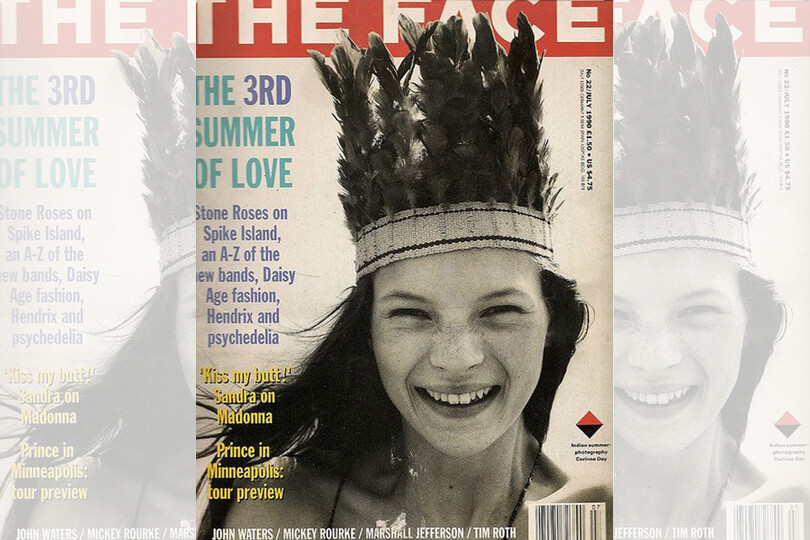
The July 1990 issue of The Face presented Moss on the cover wearing the headdress, and inside the magazine, an eight-page spread featured captivating images of the 16-year-old Moss, including one of the adolescent topless. Quite simply…a Generation X icon had been born.
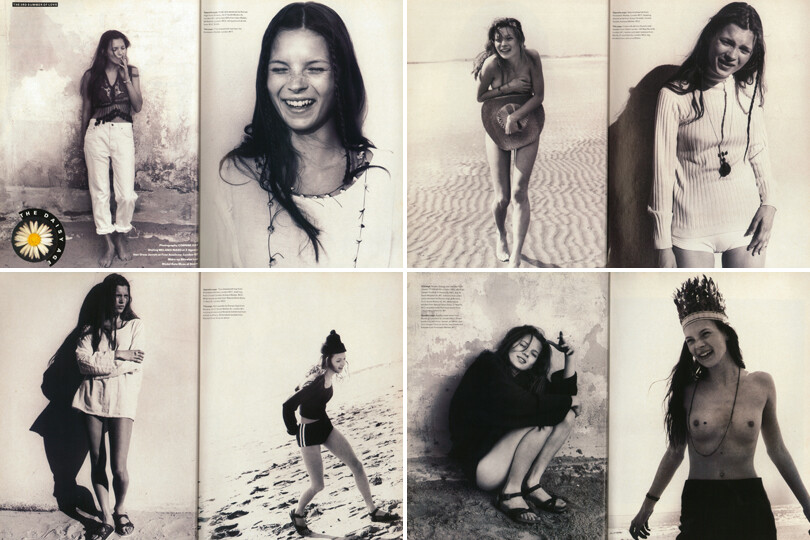
Those Calvin Klein ads
The fashion scene in the 1980s was a time when flaunting excess was de rigueur, with bold shoulders, big hair and a whole lot of bling. The more-is-more mindset was epitomized on the runways by designers like Gianni Versace, Christian Lacroix, Yves Saint Laurent, Oscar de la Renta and Chanel’s Karl Lagerfeld, who piled on the pomp and pageantry with glamorous supermodels famous for their statuesque and curvaceous frames.
That supermodel phenomenon was defined by Cindy Crawford, Naomi Campbell, Linda Evangelista, Christy Turlington, Stephanie Seymour and Claudia Schiffer. Moss was a different kind of model – in fact, the exact opposite: she represented the beginning of a new era of waif-esque beauty and grunge. Grunge was dominating the airwaves at the time, with bands like Nirvana and Hole, and films like Kids (1995) and Trainspotting (1996) would soon follow.
In 1992, Moss signed a contract to appear in an upcoming Calvin Klein ad campaign, after famed fashion photographer Patrick Demarchelier met her and recommended her to Klein, comparing her presence to that of Twiggy.
Calvin Klein’s infamous black and white TV reel was shot by the legendary Herb Ritts and starred Marky Mark (or, as we know him now, Mark Wahlberg) with his pumped-up bare chest and six-pack abs, alongside an 18-year-old Moss. The TV commercial, as well as the accompanying print ads, featured the teenager topless, wearing only Calvin Klein underwear and jeans and with her arms seductively wrapped around the hip-hop star. Even by today’s standards, the ads are provocative and unapologetically sexual.
The ad campaign provoked an immediate media explosion, while inadvertently helping to change the fashion industry’s obsession with bodacious bombshells and to launch Moss’s career into the stratosphere. Looking back recently at the iconic campaign, Moss said simply, “That’s when everything changed.”
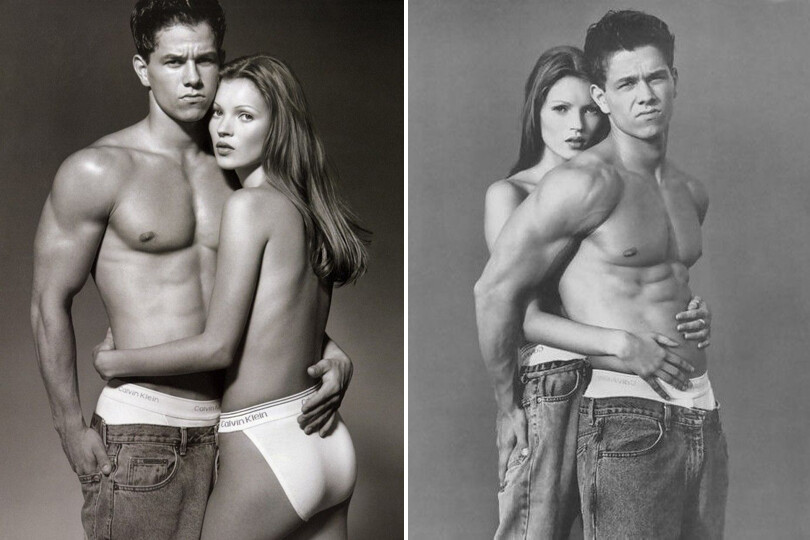
Moss’s elfin, “underfed” frame caused some alarm. While some acknowledged and appreciated her waif-like appearance, others called her anorexic. She was too skinny, the arguments went, an unrealistic, unattainable role model for the young women the commercials were targeting. The racy ads even drew criticism from then US president Bill Clinton, who would later speak out against the “heroin chic” trend.
Still, her look redefined what the American fashion brand was all about and set new trends. Gone were the big boobs and glamorous looks. The new American sex appeal was all about natural beauty and minimal makeup. The advertisement gave Moss a major breakthrough as she was noticed all around the world.
“I wasn’t the Amazonian girl that everyone in fashion was used to, with the big tits, all curvy and tall,” Moss told Glenn O’Brien, the writer behind the famous Calvin Klein ad, in 2009. “I was small in comparison. It’s funny, though, because I always thought I was as tall as, like, Christy [Turlington], and then I’d be doing her makeup in the mirror and realize that I was five inches shorter.”
Years later, Moss would open up to the press about the 1992 shoot, revealing her inner reaction to stripping down and interacting with Marky Mark on camera while she was barely clothed. “I had a nervous breakdown when I was 17 or 18, when I had to go and work with Marky Mark and Herb Ritts,” she told Vanity Fair. “It didn’t feel like me at all. I felt really bad about straddling this buff guy. I didn’t like it. I couldn’t get out of bed for two weeks. I thought I was going to die.
“I was such a nervous wreck” during the Calvin Klein shoot, she recalled. “At the time, he [Mark] was such a d**khead. He wasn’t very nice.”
When those quotes were published, Mark fired back, telling Nuts: “It was okay. I wasn’t into the waif thing. She kind of looked like my nephew.… I mean, she’s beautiful – she’s a very pretty nephew – but I’m more into curvy women.”
Klein too in recent years has opened up about what went on behind the scenes. In 2013 he said of the campaign, “I didn’t want anyone else. But [Mark] was trouble.… He and Kate couldn’t stand each other.”
Heroin chic
Less than a year later, Moss was everywhere. With her more natural look, street style, and slight build, she would be dubbed an “anti-supermodel” by the press, launching a new era in modelling. But the Calvin Klein ad campaign, as well as a high-profile spread in British Vogue (again shot by Day) that was released around the same time, caused a furor, as Moss was accused of promoting anorexia and pedophilia.
Her rise to fame was also accompanied by a controversial new fashion trend, which would become known as “heroin chic.” This look, popularized in the fashion world, was characterized by pale skin, dark circles under the eyes, skinny body and angular bone structure – essentially, models looked like they’d been on several drug-fuelled nights out. The look had an air of androgyny to it and was partly a reaction against the vibrant look of the 1980s. A 1996 article in the Los Angeles Times stated that the fashion industry had “a nihilistic vision of beauty” that was reflective of drug addiction.
Supermodel Gia Carangi is remembered for being the origin of “heroin chic,” but Moss was also a key part of the trend, thanks to her waifish look in the Calvin Klein campaigns.
The trend eventually faded due to its seedy associations and the drug-related death of fashion photographer Davide Sorrenti in 1997, but Moss’s career continued to thrive…even after Vogue magazine declared that it was time for “The Return of the Sexy Model” in 1999 and dubbed Brazilian supermodel Gisele Bündchen the ambassador of a fashionable new era.
To be continued…
Moss and her waif-like characteristics didn’t disappear with the end of the heroin chic trend at the turn of the century. In fact, she became one of the most sought-after and highest-paid models in the world. In the ensuing decades, she appeared in ad campaigns for Alexander McQueen, Dior, Burberry, Chanel, Versace, and Dolce and Gabbana, among countless others. With her iconic style, she also became a muse to a number of designers, including the late Alexander McQueen. Although many models retire by their mid-20s, Moss remained busy into the 21st century, by which time she had appeared on more than 300 magazine covers.
Her career has also withstood numerous good, bad and ugly personal scandals that have been well documented by the tabloids. One of the most notable occurred in 2005, when the Daily Mirror published photographs of Moss using drugs with her then-boyfriend, British musician Pete Doherty, and reported on her alleged cocaine addiction. The ensuing scandal resulted in a storm of negative press and most of her contracts being very publicly terminated. After a stint in rehab, she kept a low profile for six months until friend and long-time collaborator Alexander McQueen put her back on the runway – as a state-of-the-art hologram. At the show’s finale, McQueen took his bow in a black T-shirt emblazoned with the slogan: “We love you Kate.” All was forgiven by the fickle fashion world and Moss made a comeback, bagging more than 18 major modelling contracts in one season (a record), and once again becoming one of the industry’s top-earning models.
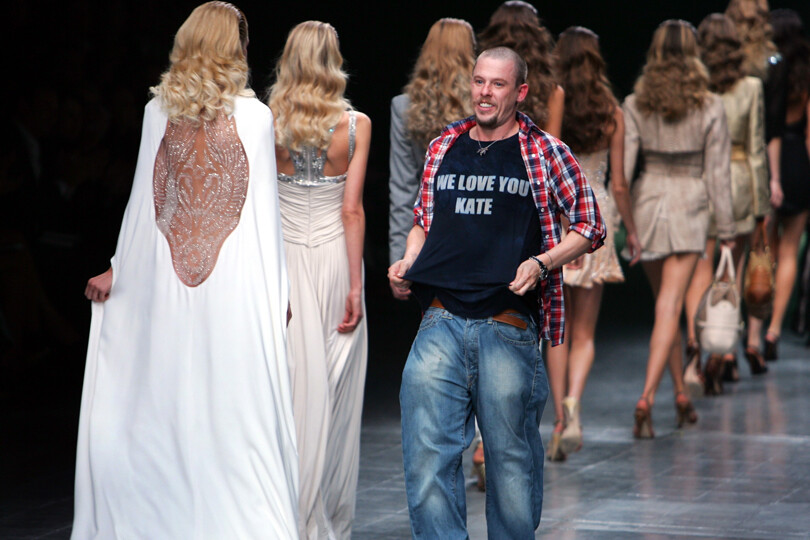
Of course, Moss’s career is still going strong today. She kicked off 2022 starring in an ad campaign celebrating the launch of Charlotte Tilbury’s latest makeup product, the Beautiful Skin Foundation, alongside Bridgerton actress Phoebe Dynevor and model Jourdan Dunn.
Despite all this, Moss has confessed that she wasn’t confident as a model at the start of her career, and didn’t develop that confidence until much later. “It’s not really until quite recently that I know – not that I’m good at it, but it is something that I can do. But that’s probably years and years of training.”
The training paid off. Moss is the ultimate fashion icon, who has proven that she is a force to be reckoned with. So, thanks to Sarah Doukas and Corinne Day for getting her started on that journey.
![]()
Want more? You can read other stories from our The Story Of series right here.

